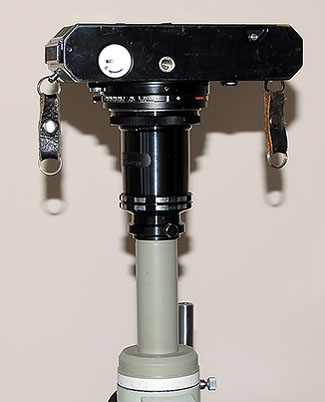
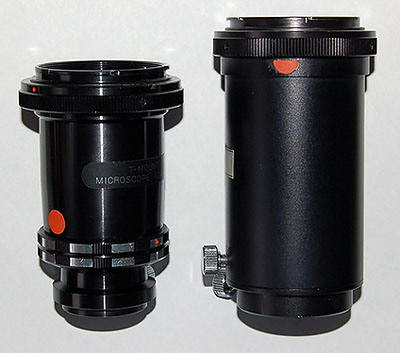
Notes on some SLR/DSLR photomicrography options for the LOMO Biolam Microscope
by David Walker, UK.
The LOMO Biolam stand pops up quite frequently on eBay and can be excellent value for the hobbyist; it has been the author's main microscope for coming up to thirty years. Fellow enthusiasts have shared articles on using, servicing and modifying the stand and these have been compiled into a Micscape LOMO resource page. This resource doesn't presently cover some LOMO photomicrography accessories, so below is a summary of three photo accessories which the author uses and which can come up for sale secondhand and/or still available new.
The notes mainly apply to the options available on the used market for the Biolam; the UK / European variant of this stand. The equivalent options available new for the US models may differ in some respects.
'Vertical monocular
tube'
VA-1
Pros: cheap, simple, effective. Image projection to camera with
no intermediate optics.
Cons: visual work impractical, more suited
to prepared slides than live work. Mechanically coupled
to microscope—camera shutter / mirror vibration needs to be assessed
and worked around. Eyepiece removal awkward to check phase or condenser
iris setting.
(UK LOMO catalogues also show another
vertical tube, the 'Camera Adaptor' CA-3, which is sturdier and has a Pentax
42 mm thread. The author has no experience of this accessory.)


Left above: The VA-1 vertical adapter shown with Nikkormat FT3 attached using a third party 35 mm SLR camera microscope adaptor and Nikon T2 mount. The eyepiece sits at the top of the monocular tube.
Right above: Third party photomicro' adaptors don't seem to be of any standard length judging by the author's two examples shown. The lefthand one has a bayonet two piece fitting to insert the eyepiece, the right hand one has a 'C' clamp fitting. A shorter design can be useful with a digital SLR to compensate to some extent for the smaller sensor cf a 35 mm film frame.
Until recently the monocular tube was the only method I've used for photography. The LOMO UK franchise seemed to have ceased sometime in the late 1990s and the other advanced accessories discussed below are hard to source new in the UK but do crop up on eBay and East European dealers' websites. New versions of the accessories below seem expensive in the US, relative to the base stand cost.
| For a simple monocular head the camera viewfinder has to be used. Critical focus can be achieved reasonably well in an SLR viewfinder if it has the central clear split-image prism. If the eye is slightly off axis, one side of the prism is bright showing a clear image of the subject, compared with the dull surrounding microprism and ground glass. SLRs with exchangeable viewfinder screens may have a more suitable viewfinder in the system range. |
|
Focussing:
The easiest approach with a standard eyepiece is to focus the subject
in the viewfinder to create a real image in the camera's film plane.
Apparently this isn't ideal if it significantly changes the objective's designed working
distance; raising the eyepiece on a short collar (as a LOMO photoeyepiece
does) or more preferable, using a focussing eyepiece
is recommended in photomicrography books (see below).
For the above
LOMO / Nikon SLR setup with a normal eyepiece, the change in focus from visual to camera
work is ca. 2 mm for the 3.5x objective and a fraction of
a full fine focus turn for the higher mags, so pending rigorous comparisons
I suspect at this level of photomicroscopy it's not too critical except perhaps
for sensitive objectives, such as dry high NAs. With the photo eyepiece for
projection the focus change is about 0.5 mm for the 3.5x objective.
'Photo-attachment' MFN-12
(US new equivalent HF-20)
Pros:
Well made, simple but effective design, parfocality readily set, visual studies maintained,
eyepiece a good height on typical table so as not to require the microscope stand
to be raised.
Cons:
Not binocular—less well suited to extended visual work. Mechanically coupled
to microscope—camera shutter / mirror vibration needs to be assessed
and worked around.
Judging from 1990s LOMO brochures / dealers' catalogues, this item wasn't widely available new in the UK but does now crop up. I obtained a used MFN-12 on eBay and I'm really taken with this accessory. It's half the weight of and simpler than the trino' head and the fuss free setting of accurate parfocality makes it my favourite of the three items discussed here.
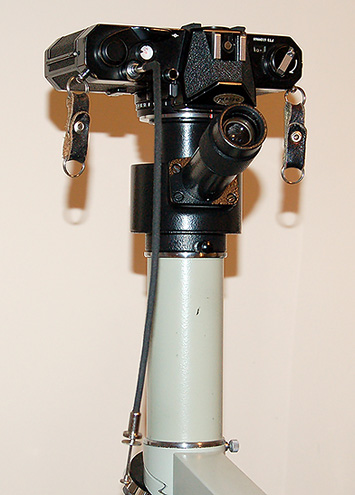
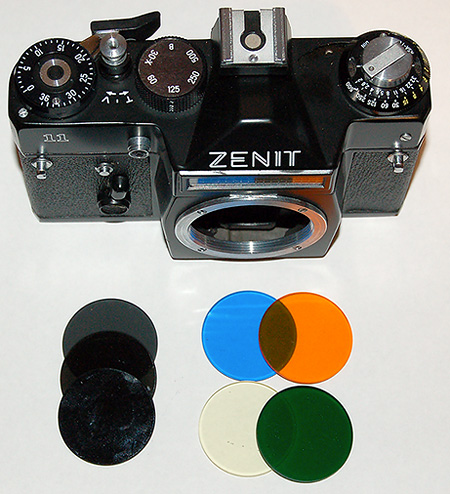
Left
above: The MFN-12 on a LOMO Biolam shown with a Nikkormat FT3 attached. The
sturdy vertical tube supplied has a dovetail fitting top and bottom. The eyepiece
sits inside the top of this tube. A field splitter (40% mono, 60% photo, source
LOMO USA website) is permanently set
for parallax focussing using the eyepiece, framing reticle and dioptre
adjustment.
Right above: The author's example dated 1988 comes with a Zenit 11. This has been modified by the makers
to be just a film holder and shutter, with reflex mirror mount bolted up. This
model had no TTL metering, so exposure determination would require careful calibration
with film developing. The good array of neutral density and colour filters are
handy though.
I can see no optics in this example apart from the prism
splitter.
For
35 mm film work, the Zenit 11 supplied is best replaced
with an SLR with through the lens metering, and preferably
mirror lock, as the Nikkormat FT3 shown left above. Used SLR bodies
are excellent value nowadays.
|
The MFN-12 head has the now dated Pentax M42 screw thread, suited for the Zenit camera supplied and e.g. old Pentax cameras. A T2 mount does have a 42 mm thread but apparently a different pitch (see links below) so will bind after a few turns and not ideal for accurate registration. A cheap solution as shown above is an M42 - bayonet adaptor, a Nikon variant is shown. These are a few pounds new on eBay. This design has a flange about 0.5 mm thick and had only a minor effect on parfocality setting. This design is OK with Nikon digital SLRs like the D200 / D300 as the outer rim just clears the AI indexing tab on camera. |
Left:
The eyepiece sits in the top of the lower tube. |
|
The full view seen in the monocular tube with frame marker for 35 mm film. |
A fine double cross is in the centre of the field for critical setting of parallax focussing. Accurate setting of parfocality takes seconds. |
Trinocular head MFN-11
(US new equivalent HT-30)
Pros:
Well made, versatile head for visual / photo work. Magnification changer / Bertrand lens.
Camera extension can be varied for appropriate field of view.
Cons:
Heavy for a moving limb stand, mag. changer ergonomics could be better, setting critical parfocality can be tricky
if camera mechanically coupled. Mechanically coupled
to microscope—camera shutter / mirror vibration needs to be assessed
and worked around. The shallow 30° bino' head may require the microscope to
be raised
to a more comfortable working height.
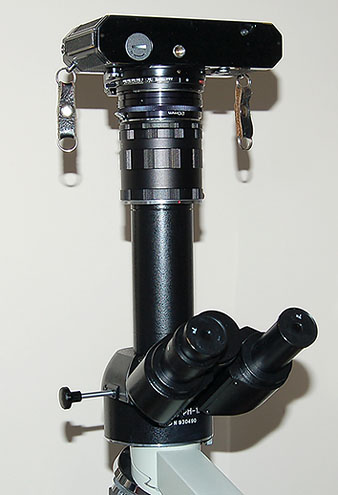
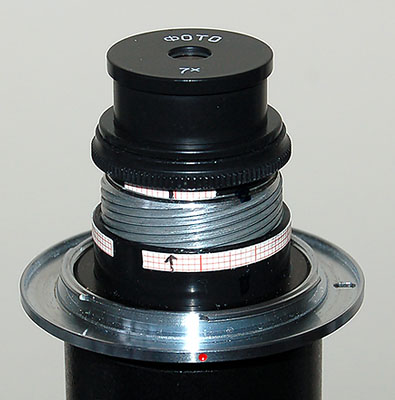
Left above: The MFN-11 on a LOMO Biolam shown with a Nikkormat FT3 attached. The plunger left offers 90%-10% or 100%-0 split between camera-bino' head (source: LOMO USA website). A click stop dial on the other side of unit gives a magnification changer 1.1x, 1.6x, 2.5x and Bertrand lens which act on both camera and visual field. The four camera tubes shown (not supplied) give a total extension of 78 mm for capturing a good non-vignetted field to fill the 35 mm film frame. The extension can be reduced to capture more of the field with vignetting if desired.
Right above: On the used trino' head the author bought dated 1993, a helical screwed eyepiece adaptor was included. The extension shown was required to give parfocality with bino' head and camera. As the mag changer introduces intermediate optics between objective and eyepiece, the author is uncertain how eyepiece extensions affects optical tube length. Graph paper strips monitor the setting.
This was expensive when still available new in the UK (£206 in 1996—more than some of the Biolam microscope outfits) and remains expensive new in the US (ca. $495). But it can crop up on eBay and if a Biolam scope is seen with one fitted, it can be more cost effective to buy the outfit as the price maybe well under the price of the trino' head alone new (how I acquired my example).
It weighs ca. 1.2 Kg without a camera attached although does seem to be held without noticeable short term focus drift if the coarse focus on my moving limb Biolam stand isn't set too free. Mid 1990s UK catalogues for the LOMO range shows that it was also the trino' head for the larger fixed limb Bimam EC R-13 research stand (and more recently for the fixed limb US Laboroscope) where it looks better balanced and perhaps more suited for a fixed limb stand.
The magnification changer and Bertrand lens is handy although the setting dial faces away from the user. My example, dated 1993, was unboxed with no eyepieces so uncertain whether it came with other accessories. The modern variant is sold as the HT-30 in the US, the specification on the LOMO US website notes that it has 'field flattening' optics. On this website a wide variety of 'vertical adapters' are apparently available for still and video cameras. The adapter supplied with the author's example is a simple aluminium eyepiece mount with helical thread.
Unfortunately, on my example of the trino' head, the visual field is noticeably not parcentral with the photo tube field by about half a field width. The head covers readily strip down for inspection without upsetting any alignment but have been unable to source where the problem lies and if adjustable. It seems to be above the mag. changer optics. Any experience from readers of correcting this fault would be of interest.
Coupled v. uncoupled camera: The accessories above were primarily designed for mechanically coupled cameras and that is the most practical method for me using the scopes in a domestic setting. But a camera supported separately on a sturdy stand may have benefits i.e. reducing vibration, setting parfocality of the trino' head photo eyepiece and finer control over the projection distance. Although a less than sturdy stand may introduce new degrees of freedom of vibration. The author's room has a suspended floor and a sturdy external stand for the camera would not necessarily solve all vibration methods.
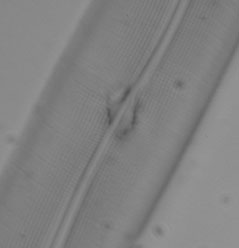
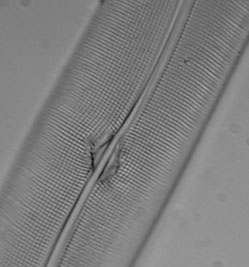
Above
left: 40x objective, crop of field, 1.6x mag on LOMO trino' head camera
coupled to head. Diatom strew by Klaus
Kemp. 1/60th sec shutter with mirror delay shows an unsharp image
because vibration occurs over a significant part of the exposure.
Above
right: As left with a 1/3rd sec exposure. On the author's photomicro
set-up / room with 40x objective a shutter speed of 1/3rd sec or
slower had to be used with shutter delay on a Nikon DSLR.
Although the author prefers flash to completely remove the effect of
vibration for medium to high mag work.
If a coupled camera is preferred, the effect of camera shutter and mirror vibration can be assessed for the setup (much quicker nowadays with digital cameras). Choosing appropriate SLR shutter speeds for a given objective, electronic flash lighting or an external shutter are established ways to minimise vibration.
Even lighting: If my experiences are typical, the LOMO lamps (OI-19 and OI-35) don't give very even lighting for photomicrography at lower powers without using heavy diffusers. For the 3.5x objective, removing the condenser and using the plano-concave side of mirror is one recommended approach and the lamp iris then acts in the same way as the condenser iris; a diffuser on the external lamp may still be required. I prefer to use a large source frosted enlarger lamp in critical illumination mode at low powers.
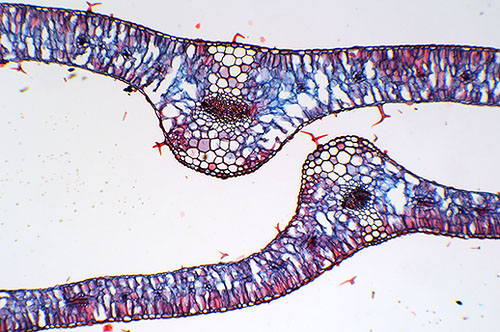
Lavender T/S leaf section, Biosil slide. Trino' head 1.1x. The wider field of this mag setting needs particular care with lighting. A photoenlarger lamp was used with Abbe condenser and bulls-eye swung in but some unevenness in the light is still apparent.
Comments to the author David Walker are welcomed.
(Revised November 2010: The accessory model numbers originally described as MFN-11 and MFN-12 were inadvertently transposed.)
Links
Micscape LOMO
resource page - a compilation of Micscape
contributors' articles.
A
design for using an enlarger stand for photomicrography by Ted Clarke
- Micscape article. A neat design for independently supporting a
camera for use with a LOMO stand and trinocular head fitted, also a lighting
design.
'Adapting a
Canon 300D (Digital Rebel) Camera for Photomicrography Through a LOMO Multiscope
Microscope' a
valuable article by Ken Vernon on the www.amateurmicrography.net
website. The author uses the LOMO trinocular head and his experiences with coupling and decoupling the camera to
the stand are particularly interesting.
Camera
mounts and registers - a valuable database maintained on 'WJ's Photo
Homepage'.
LOMO
USA - describes and illustrates the modern equivalents of the LOMO microscope
range available in the USA.
Books
on photomicrography
'Photography
through the microscope' by John Delly. Kodak Publication P-2, 1988.
Superb introduction
to microscopy as well as photomicroscopy at the DIY and more advanced level.
The author discusses projected image focussing with 'reflex cameras' on
page 41.
'Photomicrography.
A comprehensive treatise.' R. P. Loveland, 2 vols. Wiley, 1970.
A very accessible
work as the author intended it to be 'useful to the neophyte in the field' as
well as the 'experienced photomicrographer' (quotes from Author's Preface).
The author discusses aspects of projected image focussing on pages
57, 60, 150, 462.
'Tolerance to tube length change versus objective NA.'
is described on p. 57 and illustrated Fig. 2-2 p. 58.
'Photomicrography' by R M Allen. van Nostrand,
2nd edition, 1958. An earlier work but principles and fundamentals invaluable.
Microscopy UK Front Page
Micscape Magazine
Article Library
Published in the March 2008 edition of Micscape.
Please report any Web problems or offer general comments to the Micscape Editor .
Micscape is the on-line monthly magazine of the Microscopy UK web site at Microscopy-UK
©
Onview.net Ltd, Microscopy-UK, and all contributors 1995
onwards. All rights reserved.
Main site is at
www.microscopy-uk.org.uk
with full mirror
at
www.microscopy-uk.net
.